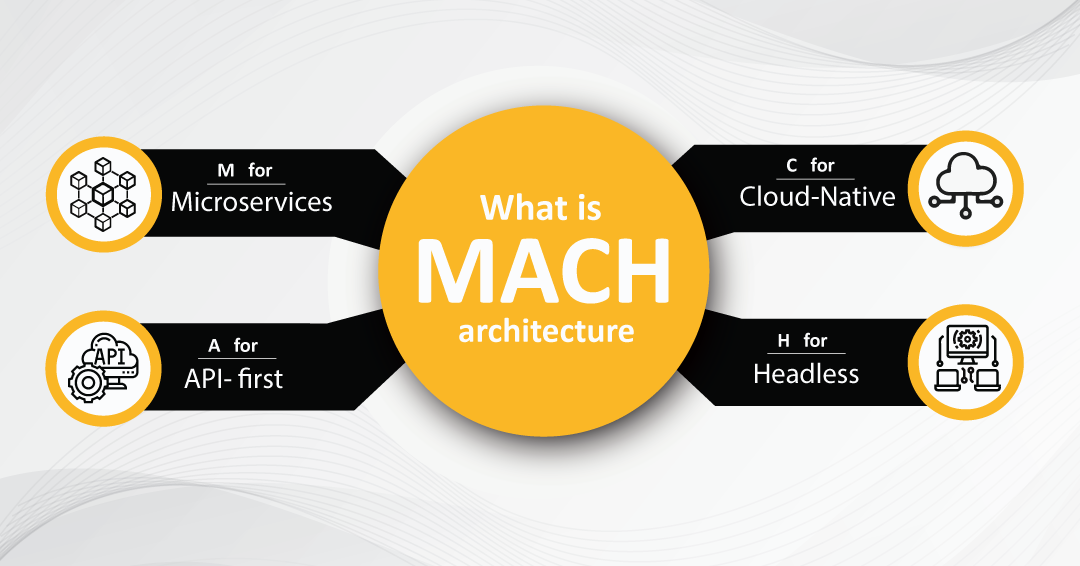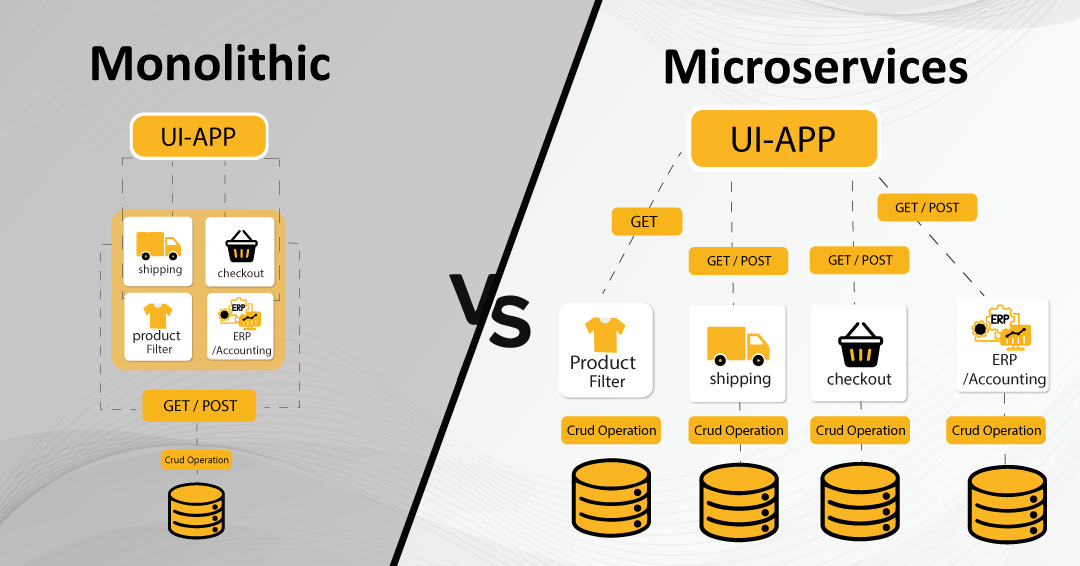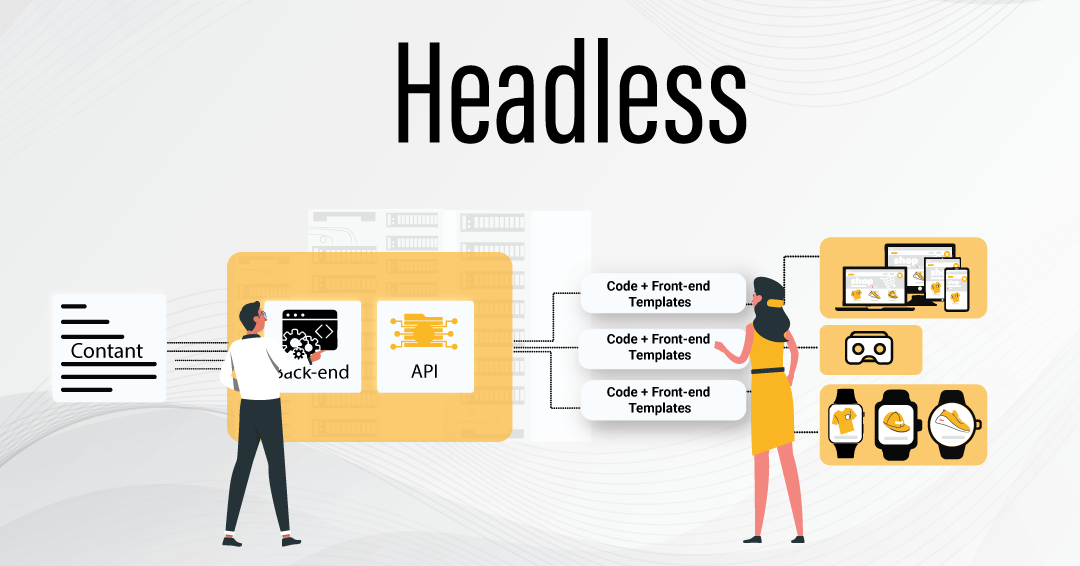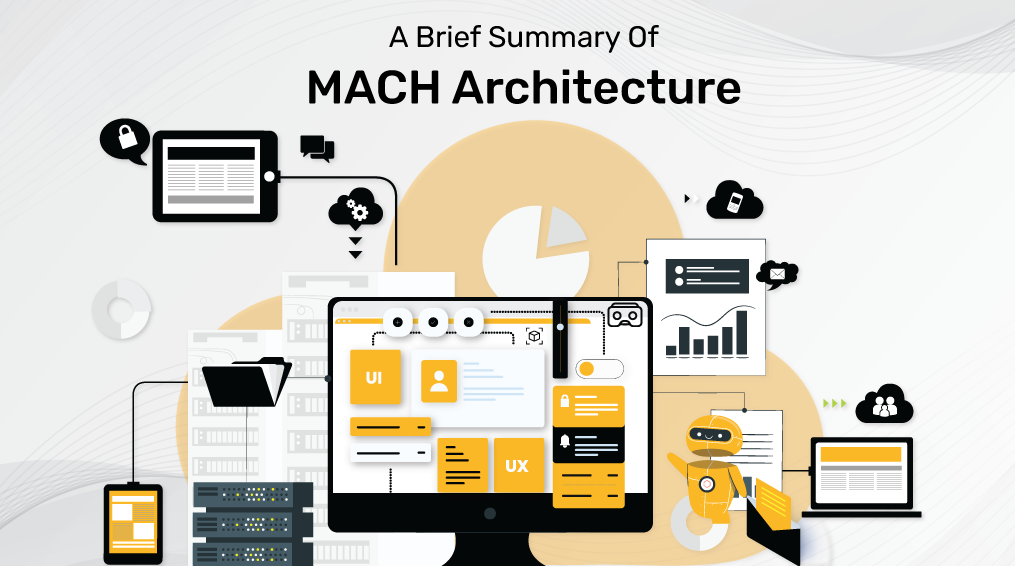A Brief Summary Of MACH Architecture
MACH architecture is a modern infrastructure for building eCommerce platforms; the acronym stands for Microservices-based, API-first, Cloud-native, and Headless.
What is MACH architecture?
MACH stands for Microservices, API-first, Cloud-native, and Headless. Some explanations may display one or more of these features but providers must complete all of these criteria (amongst others) to evolve a member of the MACH Alliance. You and your enterprise will reap more advantages and deeper rewards if your preferred technology retailers, products, and overall architecture track a pristine MACH procedure. We’ll bind each feature in more detail below.

Microservices
M stands for Microservices. Larger projects have been made up of Different modules. Breaking large projects into smaller modules that communicate with each other through simple Application Programming Interfaces (APIs). That’s Called Microservices.
MACH architecture typically includes numerous merchant explanations to make a whole solution. Each microservice solution generally performs a single process.
Every enterprise business has different modules like shipping, ERP, stock management, etc., which are connected through the Application programming interface (API) and communicate with each other through API.
The microservice-based architecture delivers several advantages:
Pros
- Easy to scale. Microservices can each be scaled unassisted in real-time based on traffic and directive for separate services.
- Smaller costs. As each service can be scaled unassisted you no longer have to over-provision server ability to expect directives, this allows you to optimize your infrastructure costs. For instance, if you’re driving a flash sale, your cart, promotion, and checkout services may require you to rise to process further requests whilst your catalog can resume being performed at no extra cost from your Content Delivery Network (CDN).
- High uptime. Downtime can be separated into particular microservices in a decoupled architecture assuring continuing or narrowly consolidated service functions in a worst-case scenario. If one service is down the others are still able to utilize it. Monotony will require to be baked in should a crucial path microservice (e.g. the cart or checkout) go down.
- Merchant flexibility. You achieve power over your whole architecture, allowing you to create slighter findings to crack exact concerns. This permits you to select best-in-class elements for each area of your business, whether that’s on the frontend, backend workflow management, or logic processing. You are also able to seamlessly write and combine your internal microservices that are separate and under your complete control.
- Faster upgrades & release cycles. Each microservice can be corrected unassisted from each other allowing the immediate escape and rollout of unique characteristics, functionality, and bug fixes that do not impact other areas of the system.

Cons
- Intricate architecture. An organization will need a technical team to execute and maintain a microservice-based architecture.
- Developer bottlenecks. Complex architecture can conduct to your technical team to become a bottleneck when it arrives to incorporate further services or build custom functionality.
- Failover monotony, The key drawback of microservices comes down to orchestration. In a decoupled or loosely coupled microservice architecture, one microservice moving down (such as the cart or checkout) may lead to a cascading impact within the integration points between microservices. Failover and monotony will be needed to confirm these mistakes are handled gracefully.
- Improved operational overheads. Whilst the software itself is indeed likely to be more scalable and more manageable to optimize from a server help perspective, you will likely require to hire an extra slight team of developers to build unique functionality and sustain this type of architecture.
Example Of Micro-Services
The best example of Microservices is Amazon. It has a lot of modules like shipping, Warehouse, stock management, etc. which communicates with each other through APIs.
API-first
The standard monolithic method to software design concentrated on making “out-of-the-box” capabilities, and entry via the APIs was generally an afterthought rather than the immediate entry point for a given component. In an API-first solution, APIs are the bedrock of a product offering, providing the full range of all features and functionality at a programmatic API level.
Pros
- Any frontend. By being API-first you are complimentary to choose any frontend technology or framework whilst providing you’ll have entry to execute any components needed.
- A better developer experience. A well-designed, abstract and compatible API will facilitate the learning curve for developers and mask some of the intricate logic that occurs behind the API layer.
- Accelerated time-to-market. With a decreased learning curve and the capacity to execute any frontend technology or framework, you can deploy unique solutions into the market rapidly.

Cons
- Developer need. There are only a couple of downsides to APIs and that is you will require a development team on hand to execute. Parallel to the liabilities of microservices this may improve your functional overheads.
- API-quality. API-first does not mean the API is well designed. Not all APIs are made equivalent and a more resonant dive into the API and design findings will require to be considered on a case by case basis by your team.
Example Of API-First
All SaaS applications and microservices are connected through the APIs in the MACH architecture.
Commercertools, SendGrid, Google Analytics, and other services communicate with BornTechies utilizing APIs. Thus, if you replace Commercetools with any other app, the infrastructure will always not be involved as you can use other apps and launch communication with BornTechies utilizing the APIs.
Cloud-native
Cloud-native directs to software that is provided via the SaaS model by insolvency during product development. This excludes non-cloud-based software that has been placed into the cloud after the fact. The SaaS model delivers many advantages for businesses that embrace this strategy.
Pros
- Turn-key. SaaS solutions can be deployed rapidly with out-of-the-box.
- Less complexity. SaaS abstracts the intricacies of hosting solutions by handling this for you.
- Augmented scalability. With SaaS deployed in the cloud, it can be auto-scaled to sustain traffic needs and match your long-term business expansion without the headaches.
- Robust & reliable. Cloud-native applications deliver built-in monotony by deploying their services to numerous data centers and availability zones to decrease latency and boost uptime and performance.
- Automatic upgrades. Unique feature escapes are managed seamlessly on your behalf, decreasing overhead.

Cons
- Black-box. The most significant drawback in an immaculately cloud-native solution is that they are normally black boxes. This can occasionally be managed to some capacity by providing adjustable components, integrations are easy and the product is well documented.
- Limited deployment possibilities. It is unlikely that a cloud-native merchandiser will present private cloud or on-premise deployment opportunities.
- Data security. Security is not extended in your hands and will require to be operated unaided with the individual SaaS vendor you choose to buy and utilize.
- Troubleshooting. With cloud-native SaaS software, it can be more challenging to distinguish where bugs and defects are located.
Example Of Cloud-native
The cloud server is easily accessible from anywhere. It’s connected through the internet. Nowadays, Most eCommerce store owners prefer to move to Cloud Server.
Below are the platforms which provide the cloud server.
Amazon Web Server
Adobe Commerce Cloud
Shopify Plus
Shopware cloud
Using These platforms for your eCommerce store, you can easily manage and access your store from any time and everywhere
Headless
The term “headless” arrives from the concept of dividing the head (frontend) with the body (backend), with the two combined through APIs.
Pros
- Any channel. Being headless permits you to deploy numerous frontend experiences (heads) across any channel or appliance. This allows your brand to connect with consumers at any touchpoint, wherever they are in their consumer journey.
- Flexibility. A headless CMS authorizes businesses to choose the right frontend tools, frameworks, and languages that match their development team’s skillset and business needs.
- Lightning-fast load times. By leveraging current technologies and frameworks, page load times can be reduced dramatically which in turn improves SEO, organic reach, and conversion rates.
- Unique business models. By splitting backend business logic from frontend views and templates enterprises can venture into contemporary business models and force revenue gain. By leveraging a headless method you could rapidly establish the latest sales channels such as social commerce, IoT/voice commerce, or curbside pick-up experiences.

Cons
- Improved cost and slower time to market. A frontend will have to be acknowledged and integrated or made from scratch. This is close though as it may only be quieter to make a standard grid-based template when reached to traditional template-driven SaaS. On the other hand, it would be much quicker to complete a personalized, individual, and differentiated knowledge with a headless architecture.
Example Of Headless
The front-end user experience is thoroughly decoupled from the back-end logic, authorizing for complete design freedom in designing the user interface and linking to other channels and devices (i.e., current applications, IoT, A/R, sensors, etc.).
How MACH Architecture Works
MACH architecture functions by accepting a huge block of elements and breaking them down into more undersized, interconnected pieces that can work more virtually in isolation. It starts with the multiple pieces required to make a feature-rich interface for online buyers.
With a standard eCommerce platform, all the elements of the storefront process are under a single instance with a single database. With microservices, these services are self-contained and have their database. This indicates there could be a distinct app for buyer support, product management, and the shopping cart. The microservices have their load balancer and implementation environment to achieve their functionalities while simultaneously charging data in their databases.

Microservices utilize service discovery to find the appropriate route of communication between each element. They then communicate with each other utilizing an API. Once the microservices have communicated with each other, they deploy fixed content to a cloud-based service that will provide the content to customers via content delivery networks (CDNs).
Microservices aid enhance the scalability of eCommerce solutions. As the whole system becomes modular, each microservice can be separately climbed through on-demand auto-scaling.
With a headless commerce setup, the API is utilized to remove information to any device including apps, smart devices, wearable tech, and social networks. When a consumer makes a buy, the API endures communication between charge processing, inventory management, and the CRM to secure all data is up to date.
Best Example of MACH Architecture In eCommerce
Amazon is an excellent instance of an online merchant following the MACH architecture. The company has been utilizing microservices since 2006 and now has thousands of microservices performing as the elements for hundreds of user interfaces.

Amazon is also a manager in the headless commerce space having made the Amazon Echo IoT device and now directing the way with Dash ordering. They make the most of a decoupled frontend and backend by seamlessly deploying code every 11.7 seconds without interrupting their services.
Conclusion
MACH architecture attracts many similarities to Service-Oriented Architecture but modernizes the process extensively, bringing the advantage of numerous unique technologies generated throughout the 2010s attaching the cloud (SaaS), API-first products, and headless microservices.
MACH architecture is the latest normal for companies scrutinizing to compete in an ever-changing, fast-moving marketplace. By leveraging MACH architecture, enterprises become more agile and aggressive in their digital plans as opposed to reactively driving changes on a slower timescale with a monolithic architecture.
Is your business technologically provided with cultivated architecture; providing you with the advantage over your competitor? Want to learn more about how your company can profit from MACH architecture? Speak to one of our solution architects today.
Born Techies –Digital Commerce agency offers Shopify, Shopware, Magento, and Bigcommerce development with the latest technologies.
Do you want to receive a free consultation about how to optimize your store and generate more sales? Reach us out at [email protected] or contact us, and we will be more than happy to help you out.

